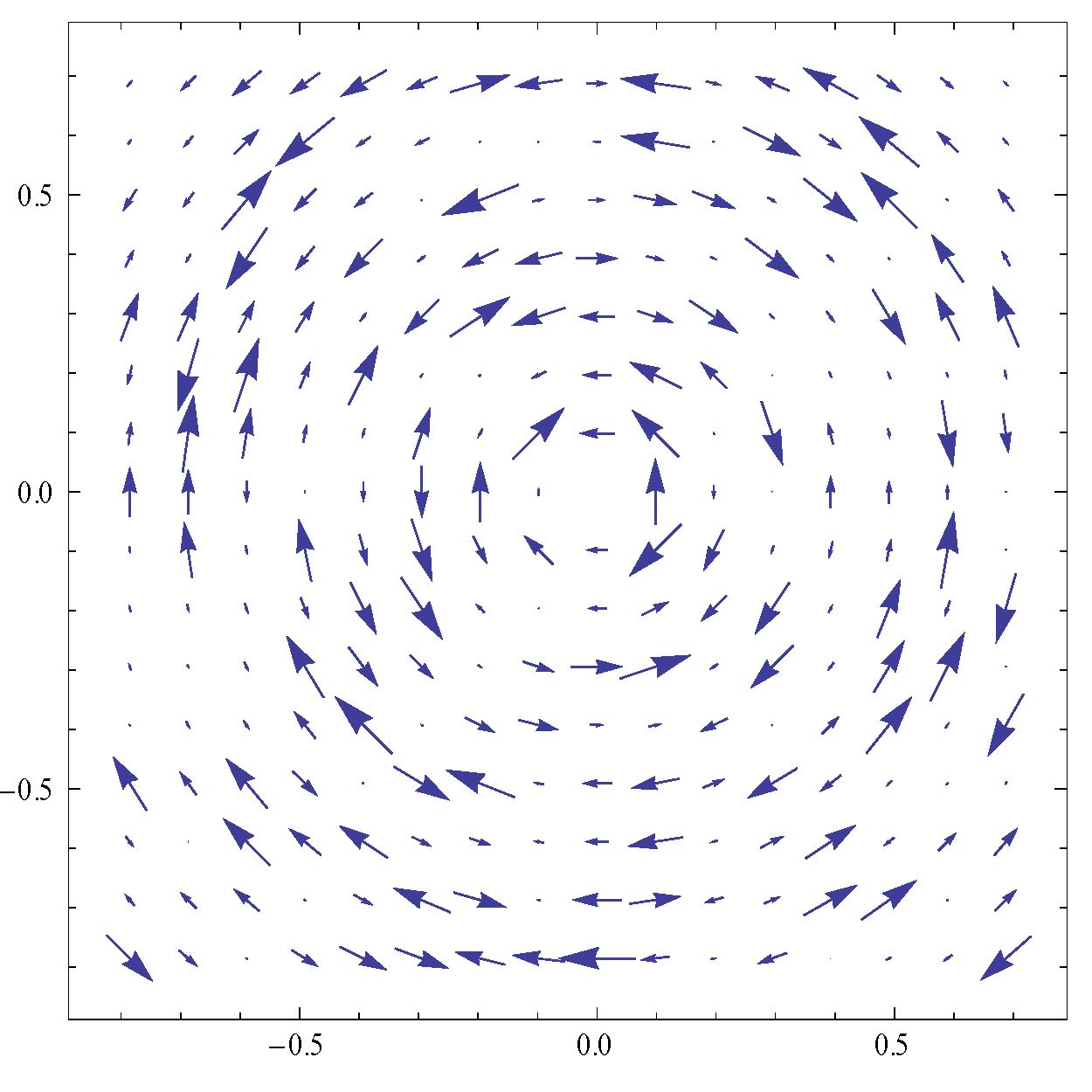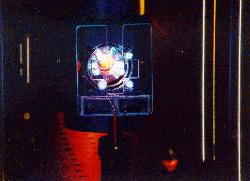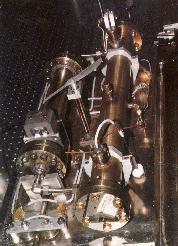
David Shelton
Email: shelton@physics.unlv.edu
Phone: (702) 895-3564
Fax: (702) 895-0804
Nonlinear Optics
The subject of nonlinear optics is concerned with the effects arising
from the nonlinear response of a medium to electric fields, at least
one of which is in the optical frequency range. Lasers are needed to
produce the intense optical fields needed to reveal the nonlinear
properties of most atoms and molecules. The applications of nonlinear
optics can be broadly classified as frequency conversion and signal
processing. In this laboratory we investigate gas, liquid and solid
nonlinear optical materials. Gases are studied because they are the
easiest to understand, and liquids and solids are studied because they
are closer to practical applications.
PUBLICATIONS
CURRENT RESEARCH
Long-range orientation correlation of molecules in dipolar liquids.
The molecular dipoles in a liquid constitute a random vector field.
The most general random vector field can be represented as the sum
of two statistically independent vector fields, one with zero divergence
(Transverse) and one with zero curl (Longitudinal), where each of these
two fields is described by its own radial correlation function. The
electrostatic dipole interaction between polar molecules in liquids
such as water results in orientation correlation between molecular
dipoles that decreases as 1/r3 with intermolecular separation.
Hyper-Rayleigh scattering (HRS) experiments, measuring the angle
and polarization dependence of second harmonic scattered light intensity,
are sensitive to this intermolecular correlation at distances as large as
1000 nm. The experimental finding for water and other polar liquids is
that the molecular dipoles are correlated to form a nearly pure Transverse
random vector field.
Dissolved ions result in an additional Longitudinal correlation of molecular
dipoles, induced by the radial electric field around each ion. The ion-induced
Longitudinal HRS contribution is experimentally distinguished by it distinctly
different spectrum and polarization dependence.


Real-space and K-space distributions for a Transverse random vector field of molecular dipoles.
EXPERIMENTS
1. Hyper-Rayleigh Light Scattering in Liquids and Gases.
 This is a second harmonic generation experiment in which the light
is scattered in all directions rather that as a narrow coherent beam.
The technique can be easily applied to study a very wide range of
materials because electrostatic fields and phase matching are not
required. Other advantages are that polarization analysis gives
information about the tensor properties, and spectral analysis of
the scattered light gives information about the dynamics. The main
disadvantage is that the signal tends to be much weaker than in
coherent harmonic generation experiments.
This is a second harmonic generation experiment in which the light
is scattered in all directions rather that as a narrow coherent beam.
The technique can be easily applied to study a very wide range of
materials because electrostatic fields and phase matching are not
required. Other advantages are that polarization analysis gives
information about the tensor properties, and spectral analysis of
the scattered light gives information about the dynamics. The main
disadvantage is that the signal tends to be much weaker than in
coherent harmonic generation experiments.
In this experiment the infrared light beam from a pulsed Nd:YAG laser
is sharply focused inside the sample cell, and the green light scattered
from the focal spot is collected by a camera lens and passed through a
spectrometer. In a typical experiment the focal intensity is
1 GW/cm2, and the detected signal is 100 photons/second.
The molecules studied range from water to large organic dyes.
2. Photochromic Signal Processing with Bacteriorhodopsin Films.
 Bacteriorhodopsin is a protein which undergoes a reversible color
change when it absorbs a photon. Bacteriorhodopsin and its various
mutants have been investigated for photonics applications including
signal processing, 3-D data storage, holographic storage, and spatial
light modulators. The work in this laboratory is aimed at producing
an optically configurable spatial light modulator suitable for
optoelectronic neural network applications. Large scale neural
networks require the massive parallelism that optics can provide.
Bacteriorhodopsin is a protein which undergoes a reversible color
change when it absorbs a photon. Bacteriorhodopsin and its various
mutants have been investigated for photonics applications including
signal processing, 3-D data storage, holographic storage, and spatial
light modulators. The work in this laboratory is aimed at producing
an optically configurable spatial light modulator suitable for
optoelectronic neural network applications. Large scale neural
networks require the massive parallelism that optics can provide.
Bacteriorhodopsin has several features which make it an attractive
starting point for designing a "smart" material, a material in which
significant information processing capability is built into the
molecular structure. The protein part ensures switching between
states of the chromophore with high quantum efficiency and without
side reactions, and genetic engineering allows one to introduce
controllable changes at the molecular scale. Presently, we are
investigating the effects of environmental parameters (temperature,
electric field) on the transitions between molecular states.
3. Electric Field Induced Second Harmonic Generation in Gases.
 The simplest example of frequency conversion is Second Harmonic Generation,
where a laser beam propagating through a nonlinear optical medium generates
a beam of light at twice the original optical frequency (for example, an
invisible infrared laser beam is converted into a beam of green light).
In such "parametric" processes, the nonlinear optical medium responds on
a time scale as short as femtoseconds, but large effects often require
light intensities greater than 1 MW/cm2.
The simplest example of frequency conversion is Second Harmonic Generation,
where a laser beam propagating through a nonlinear optical medium generates
a beam of light at twice the original optical frequency (for example, an
invisible infrared laser beam is converted into a beam of green light).
In such "parametric" processes, the nonlinear optical medium responds on
a time scale as short as femtoseconds, but large effects often require
light intensities greater than 1 MW/cm2.
In the present experiments, the quadratic and cubic nonlinearities of
isolated molecules are determined from measurements of the intensity
of the frequency-doubled light beam, produced when a strong electric
field is applied to a gas sample through which a laser beam passes.
This experiment gives very accurate measurements of the nonlinear
optical properties of small molecules. These measurements are
important because they are a direct test of theoretical calculations
for the same molecules.

 This unique research facility uses periodic phase matching in a
periodic electrode array to permit accurate gas phase hyperpolarizability
measurements for a wide range of molecules, using cw and pulsed lasers,
with wavelengths over the near-infrared and visible. The experiment
currently uses a Nd:YAG laser which emits infrared light pulses with
a power of 10 kW. The strength of the second harmonic signal generated
in the sample is increased up to 10,000 times by using an electrode array
in which the field periodically changes sign. The sample cell and
sample handling apparatus is constructed to operate at temperatures
up to 200 C. This allows gas phase measurements of molecules such
as para-nitroaniline, which are closely related to chromophores of
immediate practical interest.
This unique research facility uses periodic phase matching in a
periodic electrode array to permit accurate gas phase hyperpolarizability
measurements for a wide range of molecules, using cw and pulsed lasers,
with wavelengths over the near-infrared and visible. The experiment
currently uses a Nd:YAG laser which emits infrared light pulses with
a power of 10 kW. The strength of the second harmonic signal generated
in the sample is increased up to 10,000 times by using an electrode array
in which the field periodically changes sign. The sample cell and
sample handling apparatus is constructed to operate at temperatures
up to 200 C. This allows gas phase measurements of molecules such
as para-nitroaniline, which are closely related to chromophores of
immediate practical interest.
4. Electric Field Induced Birefringence (Kerr Effect) in Gases.
 The cubic nonlinearity of isolated molecules is determined from
measurements of the depolarization of a laser beam as it propagates
through a sample to which a transverse electric field has been applied.
When the results of this experiment are combined with the results of
the electric-field-induced second harmonic generation experiment,
they allow one to clearly distinguish the nuclear and electronic
contributions to the nonlinear optical response of a molecule
(effects of the motion of the atomic nuclei as compared to effects
of the motion of the electrons around the nuclei). The experiment
uses argon-ion, dye, and He-Ne lasers producing continuous low power
light beams in the near infrared and visible. The apparatus measures
birefringent phase shift with nanoradian sensitivity.
The cubic nonlinearity of isolated molecules is determined from
measurements of the depolarization of a laser beam as it propagates
through a sample to which a transverse electric field has been applied.
When the results of this experiment are combined with the results of
the electric-field-induced second harmonic generation experiment,
they allow one to clearly distinguish the nuclear and electronic
contributions to the nonlinear optical response of a molecule
(effects of the motion of the atomic nuclei as compared to effects
of the motion of the electrons around the nuclei). The experiment
uses argon-ion, dye, and He-Ne lasers producing continuous low power
light beams in the near infrared and visible. The apparatus measures
birefringent phase shift with nanoradian sensitivity.
5. Laser Cooling and Trapping of Atoms.
 A wide range of coherent and nonlinear interactions occur when
laser light is resonant with strong optical transitions in atoms.
Laser sources and spectroscopic techniques for cooling and trapping
rubidium atoms in a magneto-optic trap are being developed for the
production and study of cold atoms. Much of the development work
in this project has been done by undergraduate students in the
Research Experience for Undergraduates program supported by the
National Science Foundation.
A wide range of coherent and nonlinear interactions occur when
laser light is resonant with strong optical transitions in atoms.
Laser sources and spectroscopic techniques for cooling and trapping
rubidium atoms in a magneto-optic trap are being developed for the
production and study of cold atoms. Much of the development work
in this project has been done by undergraduate students in the
Research Experience for Undergraduates program supported by the
National Science Foundation.
Return to Physics Home Page
 The simplest example of frequency conversion is Second Harmonic Generation,
where a laser beam propagating through a nonlinear optical medium generates
a beam of light at twice the original optical frequency (for example, an
invisible infrared laser beam is converted into a beam of green light).
In such "parametric" processes, the nonlinear optical medium responds on
a time scale as short as femtoseconds, but large effects often require
light intensities greater than 1 MW/cm2.
The simplest example of frequency conversion is Second Harmonic Generation,
where a laser beam propagating through a nonlinear optical medium generates
a beam of light at twice the original optical frequency (for example, an
invisible infrared laser beam is converted into a beam of green light).
In such "parametric" processes, the nonlinear optical medium responds on
a time scale as short as femtoseconds, but large effects often require
light intensities greater than 1 MW/cm2.



 This is a second harmonic generation experiment in which the light
is scattered in all directions rather that as a narrow coherent beam.
The technique can be easily applied to study a very wide range of
materials because electrostatic fields and phase matching are not
required. Other advantages are that polarization analysis gives
information about the tensor properties, and spectral analysis of
the scattered light gives information about the dynamics. The main
disadvantage is that the signal tends to be much weaker than in
coherent harmonic generation experiments.
This is a second harmonic generation experiment in which the light
is scattered in all directions rather that as a narrow coherent beam.
The technique can be easily applied to study a very wide range of
materials because electrostatic fields and phase matching are not
required. Other advantages are that polarization analysis gives
information about the tensor properties, and spectral analysis of
the scattered light gives information about the dynamics. The main
disadvantage is that the signal tends to be much weaker than in
coherent harmonic generation experiments.
 Bacteriorhodopsin is a protein which undergoes a reversible color
change when it absorbs a photon. Bacteriorhodopsin and its various
mutants have been investigated for photonics applications including
signal processing, 3-D data storage, holographic storage, and spatial
light modulators. The work in this laboratory is aimed at producing
an optically configurable spatial light modulator suitable for
optoelectronic neural network applications. Large scale neural
networks require the massive parallelism that optics can provide.
Bacteriorhodopsin is a protein which undergoes a reversible color
change when it absorbs a photon. Bacteriorhodopsin and its various
mutants have been investigated for photonics applications including
signal processing, 3-D data storage, holographic storage, and spatial
light modulators. The work in this laboratory is aimed at producing
an optically configurable spatial light modulator suitable for
optoelectronic neural network applications. Large scale neural
networks require the massive parallelism that optics can provide.


 The cubic nonlinearity of isolated molecules is determined from
measurements of the depolarization of a laser beam as it propagates
through a sample to which a transverse electric field has been applied.
When the results of this experiment are combined with the results of
the electric-field-induced second harmonic generation experiment,
they allow one to clearly distinguish the nuclear and electronic
contributions to the nonlinear optical response of a molecule
(effects of the motion of the atomic nuclei as compared to effects
of the motion of the electrons around the nuclei). The experiment
uses argon-ion, dye, and He-Ne lasers producing continuous low power
light beams in the near infrared and visible. The apparatus measures
birefringent phase shift with nanoradian sensitivity.
The cubic nonlinearity of isolated molecules is determined from
measurements of the depolarization of a laser beam as it propagates
through a sample to which a transverse electric field has been applied.
When the results of this experiment are combined with the results of
the electric-field-induced second harmonic generation experiment,
they allow one to clearly distinguish the nuclear and electronic
contributions to the nonlinear optical response of a molecule
(effects of the motion of the atomic nuclei as compared to effects
of the motion of the electrons around the nuclei). The experiment
uses argon-ion, dye, and He-Ne lasers producing continuous low power
light beams in the near infrared and visible. The apparatus measures
birefringent phase shift with nanoradian sensitivity.
 A wide range of coherent and nonlinear interactions occur when
laser light is resonant with strong optical transitions in atoms.
Laser sources and spectroscopic techniques for cooling and trapping
rubidium atoms in a magneto-optic trap are being developed for the
production and study of cold atoms. Much of the development work
in this project has been done by undergraduate students in the
Research Experience for Undergraduates program supported by the
National Science Foundation.
A wide range of coherent and nonlinear interactions occur when
laser light is resonant with strong optical transitions in atoms.
Laser sources and spectroscopic techniques for cooling and trapping
rubidium atoms in a magneto-optic trap are being developed for the
production and study of cold atoms. Much of the development work
in this project has been done by undergraduate students in the
Research Experience for Undergraduates program supported by the
National Science Foundation.